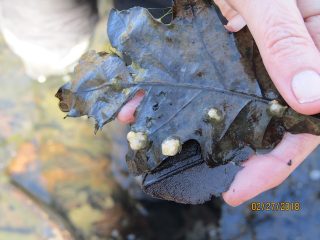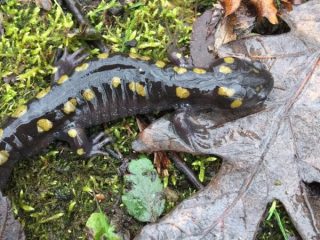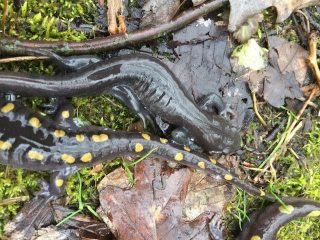Welcome to this weeks nature post!
Featuring an entry from First UU member, Dana Reynolds, who gives us the experience of going out to explore the vernal pools that are coming to life at the end of winter with the critters that harken the arrival of spring, amphibians! I’ve included some links after his article that I hope you will check out and learn more about salamanders, frogs & toads.
Little known amphibian related fun fact about Brian: I was particularly interested in this topic because as a high-school student I was seriously considering the possibility of studying zoology/herpetology (reptiles and amphibians) in college. I was involved with a junior zoologist club at the Cincinnati Zoo, and in the late 1970’s was a founding member of the Greater Cincinnati Herpetological Society at the Cincinnati Museum of Natural History. Thanks to the infinite patience & support of my mom and dad, my bedroom at home (and our basement & porch) was home to a dozen or more aquariums & cages with every manner of snake, lizard, turtle, salamander, toad… (and other rescued critters). And every spring and summer saw my friends and I tromping out to the woods and swampy areas looking to find what we could. Dana’s blog entry brought back a lot of fond memories! Enjoy.
Brian Hagemann

Salamander’s Big Night 2020!
by Dana Reynolds,
Once a year, salamanders leave their homes in the woods and head toward vernal pools, temporary ponds created by spring rains and melting winter snow (when there was such a thing). The conditions must be just right, a warm night with raining conditions. The males arrive first and lay sperm sacks around the pound. The females come later and absorb these sacks, which causes them to lay their eggs, about 50-100 per female. The eggs then hatch and juvenile salamanders (in Ohio, usually the yellow-spotted, and the occasional Jefferson salamanders).
When summer arrives, the juveniles are much bigger and will leave the vernal pool (“vernal” means Spring) before the mid-to-late summer drought arrives and dries up the pools. They travel to woodlands, generally close to where their parents live, and find burrows underneath logs to call home. A yellow-spotted salamander generally lives within 10 meters (10.81 ft) from the pool they were born (hatched) in.
The yellow-spotted salamander is the state salamander of Ohio, probably because they are so numerous of all mole salamander species. The Jefferson salamander is a key harbinger of clean water in vernal pools. They are more sensitive to pollution than most of their species.
Links to other resources on salamanders and amphibians in Ohio
- https://www.metroparks.net/blog/coming-soon-to-a-vernal-pool-near-you/
2018 article from the Metroparks Blog on vernal pool amphibians - http://ohioamphibians.com/index.html
THE definitive online portal for all things amphibian in Ohio! - https://cfaes.osu.edu/news/articles/ohio’s-salamanders-24-good-things-know-and-what-they-can-tell-you
Ohio has about 40 amphibian species, including 24 species of salamanders. This article includes 24 things to know about salamanders. - https://wildlife.ohiodnr.gov/portals/wildlife/pdfs/publications/id%20guides/pub348.pdf
PDF version of the Amphibians of Ohio Field Guide – excellent guide with maps and photos of salamanders, newts, frogs & toads. - And here’s a short documentary video from the Discovery Channel about vernal pools:
https://www.youtube.com/watch?v=fzI_yaY_j-Q
About Dana F Reynolds, III:






